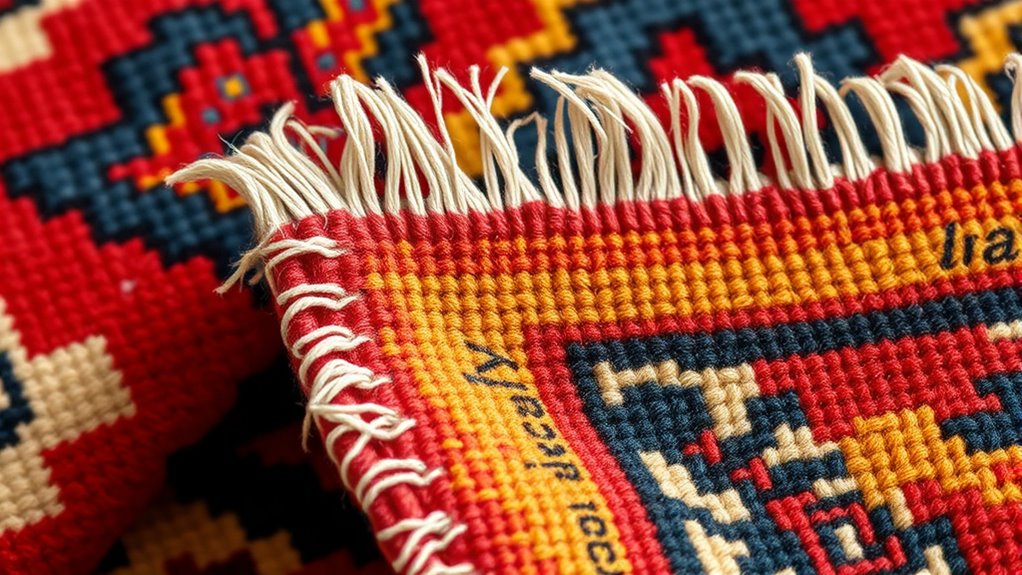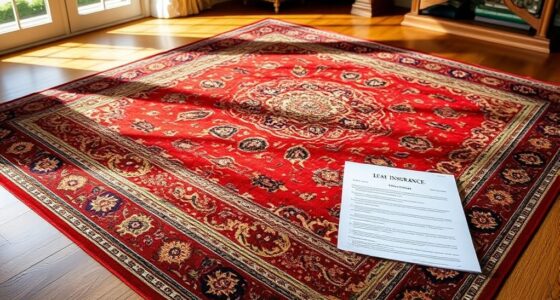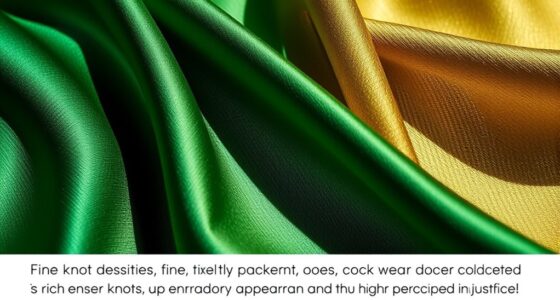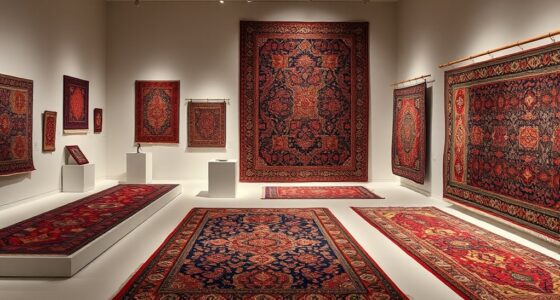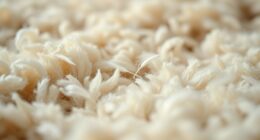Decoding rug signatures and stamps helps you uncover a piece’s origin, authenticity, and cultural background. You’ll find marks like handwritten signatures, factory stamps, symbols, and labels that reveal the weaver, region, and date of production. Recognizing these signs guarantees proper dating, provenance confirmation, and valuation. By understanding common symbols and markings, you can distinguish genuine rugs from forgeries and appreciate their history more deeply—discover more details as you explore further.
Key Takeaways
- Rug signatures and stamps reveal origin, maker, workshop, and date, aiding in authenticating and tracing provenance.
- Recognizing regional motifs, symbols, and weaving techniques helps determine cultural background and historical context.
- Authentic stamps are crisp and well-defined; forgeries often show uneven strokes and blurry details.
- Materials, dyes, and motifs indicate specific regions and time periods, supporting accurate dating and regional identification.
- Expert analysis and comparison with reputable sources enhance verification, valuation, and appreciation of rug provenance.
Understanding the Significance of Rug Signatures and Stamps
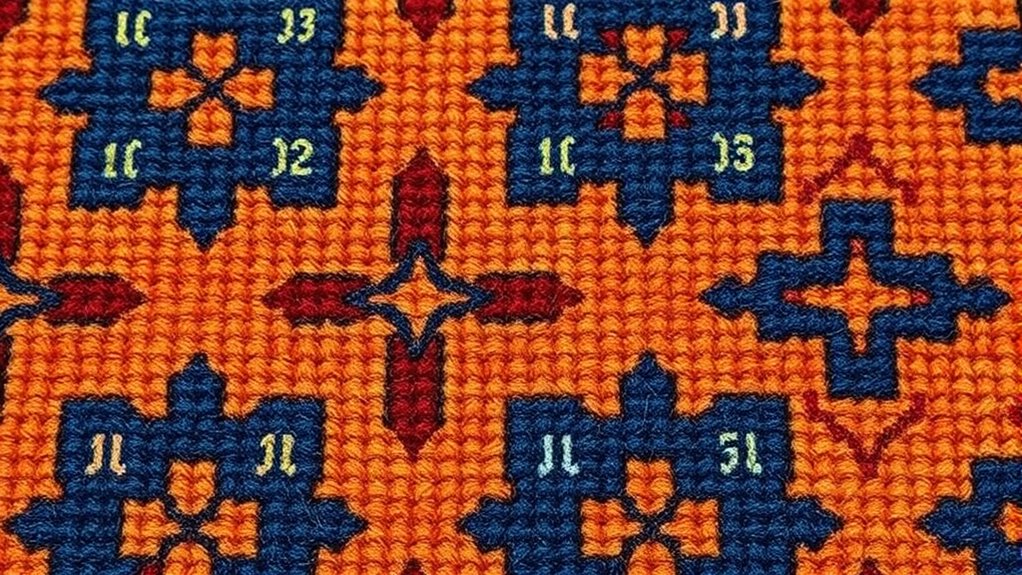
Rug signatures and stamps serve as vital clues to a piece’s origin and authenticity. When you see these markings, they can reveal who made the rug, the workshop or region it came from, and sometimes even the date of production. Signatures often appear as embroidered initials or symbols from the weavers themselves, adding a personal touch to the piece. Stamps, usually applied during manufacturing, identify the producer or certifying body. Recognizing these marks helps you verify a rug’s provenance, ensuring it’s genuine and properly valued. They also provide insight into the cultural and historical background of the rug, enriching your understanding of its story. Paying attention to signatures and stamps can also indicate the safety features and quality of the materials used in the rug’s creation. By paying attention to signatures and stamps, you gain a deeper appreciation of the craftsmanship and origins behind each extraordinary piece.
Common Types of Markings Found on Rugs

You’ll often notice a variety of markings on rugs that provide valuable clues about their origin and history. Common markings include signatures, stamps, and labels placed by artisans, traders, or owners. Signatures are usually handwritten or woven into the rug’s design, indicating the weaver or workshop. Stamps, often from factories or exporters, are stamped onto the back or side, showing manufacturing details or country of origin. Labels are sewn or attached tags that specify the rug’s provenance, age, or quality. These markings can also include numerical codes or symbols used for inventory or grading purposes. Recognizing these markings helps you authenticate a rug and trace its journey through time and trade. By understanding these common markings, you gain valuable insights into a rug’s background. Additionally, some stamps and signatures may include specific date marks that help determine the rug’s age and historical context.
Key Symbols and Their Meanings in Provenance
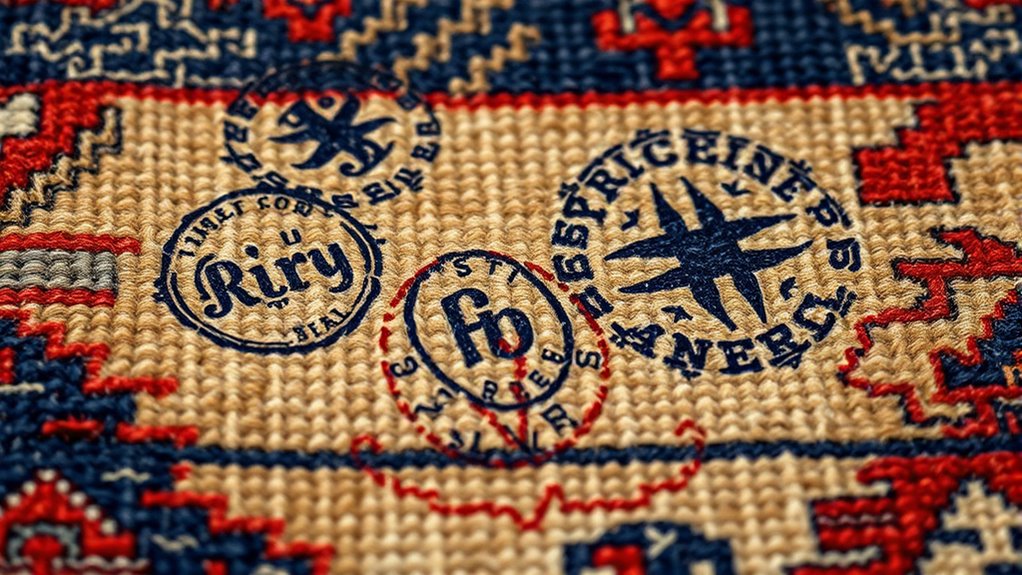
Have you ever noticed symbols woven or stamped onto a rug that seem to carry hidden messages? These symbols often reveal details about the rug’s origin, maker, or purpose. For example, geometric shapes might indicate a specific tribe or region, while floral motifs could symbolize cultural symbolism. A crescent moon or star might point to Islamic craftsmanship, and certain animals like eagles or lions can signify power or protection. Some symbols act as signatures, identifying the artisan or workshop, while others denote the rug’s intended use—like a ceremonial or everyday piece. Recognizing these symbols helps you understand the story behind the rug, connecting you to its cultural roots. Learning their meanings enhances your appreciation and confidence in evaluating authenticity and provenance. Being familiar with rug symbols and their meanings allows collectors and enthusiasts to better assess the quality and origin of a piece.
How to Identify Authentic Signatures and Stamps
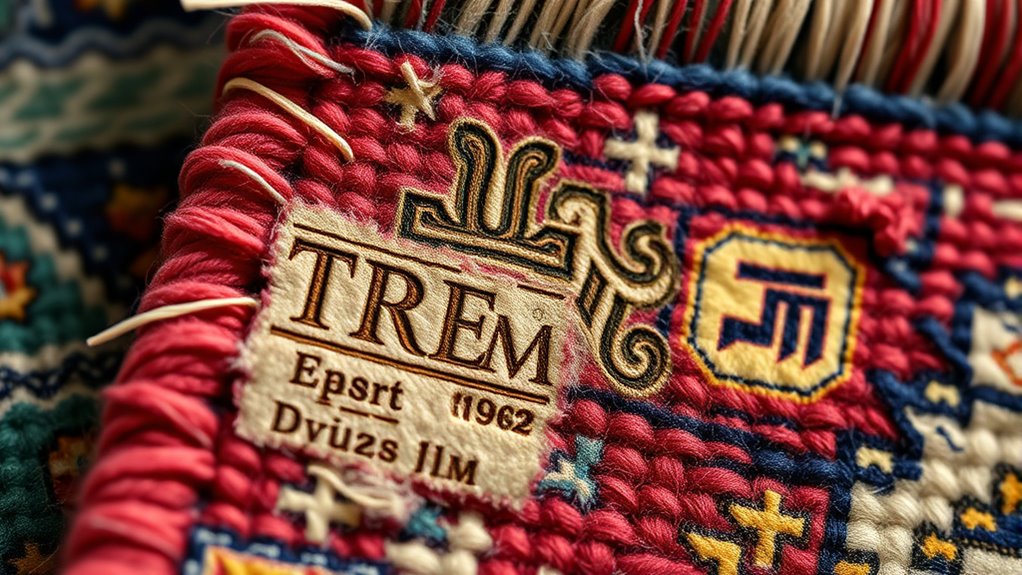
To determine if signatures and stamps are genuine, you need to recognize the key features that set them apart from forgeries. Verifying authenticity involves closely examining the markings for consistency with known examples and checking for signs of tampering. Mastering these steps helps you confidently establish the provenance of valuable items. Additionally, understanding the types of signatures and stamps used can aid in distinguishing authentic marks from counterfeit ones.
Recognizing Genuine Markings
Authentic signatures and stamps often exhibit subtle details that set them apart from forgeries. Look closely at the ink or dye; genuine markings typically have consistent pressure and smooth lines, while forgeries may show uneven strokes or hesitations. Examine the size and placement—authentic signatures usually follow established patterns and are proportionate to the rug’s design. Pay attention to the wear and aging; genuine markings often show signs of fading or slight smudging consistent with the rug’s overall age. Check for clarity and sharpness in the details—authentic stamps tend to be crisp and well-defined, whereas counterfeit ones may appear blurry or inconsistent. Scrutinizing these nuances helps verify rug signatures and stamps, allowing you to better distinguish genuine markings from imitations.
Verifying Authentic Signatures
When verifying authentic signatures and stamps, careful inspection is essential to distinguish genuine markings from forgeries. Start by examining the signature’s flow and consistency; authentic signatures usually have smooth, confident strokes without hesitation. Compare the signature with verified examples from trusted sources, paying attention to unique stylistic details and letter formations. Look for signs of tampering, such as uneven ink, smudges, or inconsistent pressure. Authentic stamps often have precise, clean impressions, while forgeries may show uneven edges or blurry details. Use a magnifying glass if needed to detect subtle differences. If possible, consult experts or use scientific methods like ink analysis. Trust your instincts, but verify thoroughly before accepting a signature or stamp as genuine. Additionally, understanding paint application techniques can help identify authentic markings related to artwork provenance.
Tracing the Origin: Regional and Cultural Indicators
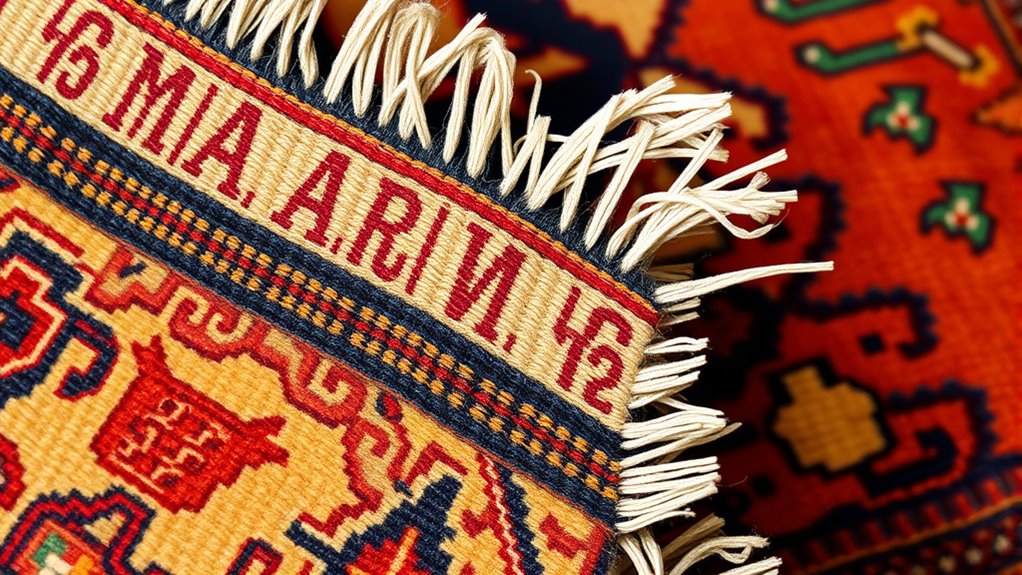
Regional and cultural indicators serve as essential clues in tracing the origin of provenance. These clues include specific motifs, weaving techniques, and color palettes unique to certain areas. For example, the geometric patterns found in Persian rugs differ from the floral designs typical of Turkish carpets. The choice of dyes, whether natural or synthetic, also reveals regional practices. Additionally, the materials used—such as wool, silk, or cotton—can point to particular regions known for their craftsmanship. You can identify cultural influences through symbols and motifs that reflect local beliefs or traditions. By closely examining these details, you gain insight into where and how a rug was made, helping you establish a more accurate provenance. Recognizing these indicators enhances your understanding of a rug’s unique history and cultural significance, especially when considering the dyes used which often hold regional importance.
The Role of Signatures and Stamps in Dating a Rug
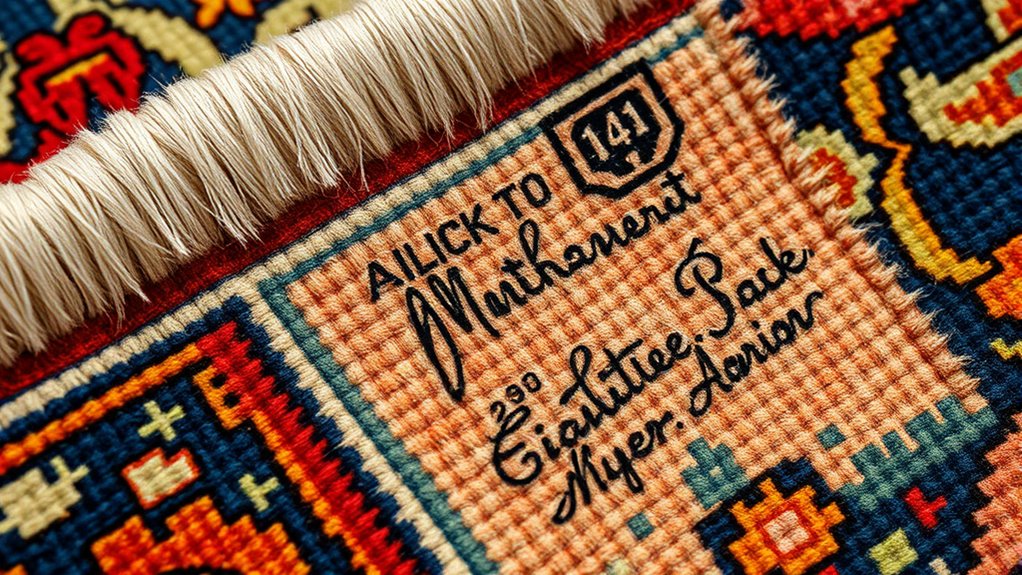
Signatures and stamps on a rug can provide valuable clues for dating its creation, as they often reflect specific periods, workshops, or artisans’ practices. These marks can indicate the time frame when the rug was made, especially if the signature style or stamp design changed over the years. For example, certain stamps were only used during particular manufacturing eras or by specific workshops, helping you narrow down the rug’s age. Additionally, signatures from well-known artisans can be linked to specific decades or regions, offering further dating precision. While sometimes these marks are subtle or partially worn, careful examination can reveal important chronological information. Recognizing these signatures and stamps allows you to piece together a more accurate timeline of your rug’s production. Access to real-time news sources and platforms can also aid in understanding historical context related to specific signatures or stamps found on antiques.
Interpreting Manufacturer and Artisan Markings
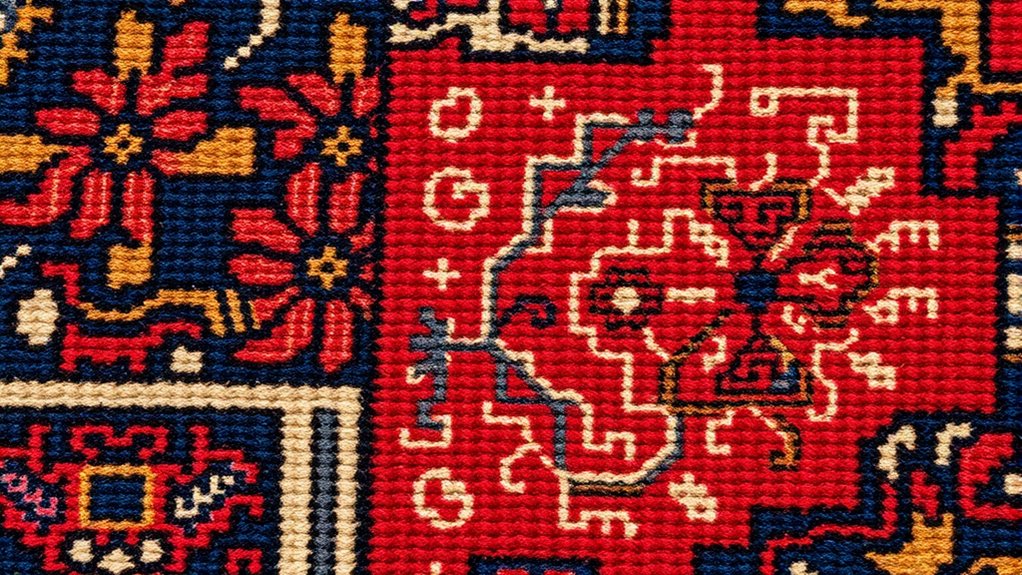
Interpreting manufacturer and artisan markings can reveal a wealth of information about a rug’s origins and production history. These markings often include logos, initials, or symbols unique to specific workshops or artisans, helping you identify where and when the rug was made. By examining the style, placement, and design of these markings, you can determine whether a rug was handcrafted by a skilled artisan or produced in a factory setting. Sometimes, markings include regional identifiers or even the name of the weaver, offering insight into its cultural background. Recognizing these details allows you to trace the rug’s provenance more accurately, understand production methods, and assess its historical significance. Proper interpretation of these markings enhances both appreciation and authentication of your rug. Additionally, understanding Honda Tuning techniques can provide insights into how craftsmanship and modifications influence the value and authenticity of collectible items.
Tips for Collectors: Confirming Authenticity and Valuation
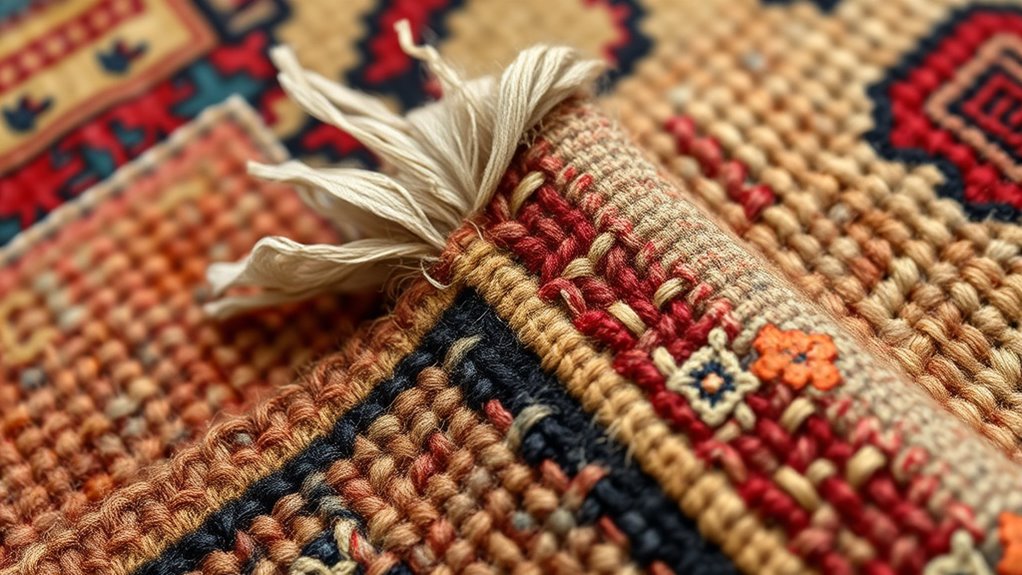
When evaluating a rug’s authenticity and value, careful inspection of markings and craftsmanship is key. Look closely at signatures, stamps, and symbols to verify their legitimacy. Compare these details with reputable sources or expert references to spot inconsistencies or fakes. Examine the weaving technique, dye quality, and material to assess craftsmanship; authentic pieces often display meticulous detail and uniformity. Consult appraisers or trusted collectors for valuation, especially when uncertain. Research the rug’s origin, provenance, and any documented history to support its authenticity. Keep records of previous sales, certifications, and expert opinions. Additionally, understanding the Worth – Kiss Me can provide context for assessing the potential market value of a collectible rug. By combining visual inspection with research and expert advice, you’ll confidently confirm whether a rug is genuine and accurately gauge its worth.
Frequently Asked Questions
How Do Signatures Affect a Rug’S Monetary Value?
Signatures on a rug can substantially boost its monetary value, especially if they indicate the piece’s origin or creator. When you identify a signature from a renowned weaver or a specific region, it confirms authenticity and rarity, making the rug more desirable to collectors. This provenance detail adds a story and uniqueness, which often results in a higher price. So, always pay attention to signatures when evaluating a rug’s worth.
Are All Signatures and Stamps Present on Every Antique Rug?
Not all antique rugs have signatures and stamps. Many rugs, especially older or traditional ones, lack these markings altogether. When present, signatures and stamps can help identify the origin or artist, but their absence doesn’t diminish a rug’s value or authenticity. You should assess a rug’s quality, age, and craftsmanship first, rather than relying solely on signatures or stamps to determine its worth or provenance.
Can Signatures Reveal the Specific Artisan or Workshop?
You wonder if signatures can identify the specific artisan or workshop. In most cases, signatures or stamps do offer valuable clues, often indicating the maker or origin. However, not all rugs feature signatures, and some may be ambiguous or forged. By carefully examining these marks, you can sometimes trace a rug back to a particular workshop or artisan, helping you understand its history and authenticity better.
What Are Common Mistakes in Interpreting Rug Markings?
You might think interpreting rug markings is a walk in the park, but don’t fall for that! Common mistakes include assuming signatures always indicate authenticity, ignoring cultural context, or mistaking artistic symbols for signatures. You could easily overlook subtle nuances or misread a stamp’s meaning. Always double-check with expert sources, research cultural symbols thoroughly, and remember that markings can be stylized or misleading—so don’t jump to conclusions too quickly!
How Do Environmental Factors Impact the Preservation of Signatures?
Environmental factors greatly impact how well signatures on rugs are preserved. You should keep rugs away from direct sunlight, which causes fading, and avoid high humidity that promotes mold and deterioration. Temperature fluctuations can weaken fibers, making signatures more fragile. Regular cleaning and proper storage help maintain the signatures’ clarity. By controlling these conditions, you guarantee the signatures stay legible and intact, preserving the rug’s authenticity and value over time.
Conclusion
By understanding rug signatures and stamps, you can uncover their true story and value. Recognizing these markings helps you trace origins and authenticate pieces with confidence. Are you ready to dive deeper into the fascinating world of rug provenance and discover the rich history woven into every thread? With a keen eye and some knowledge, you’ll appreciate the artistry and history behind each rug even more. Happy collecting!
